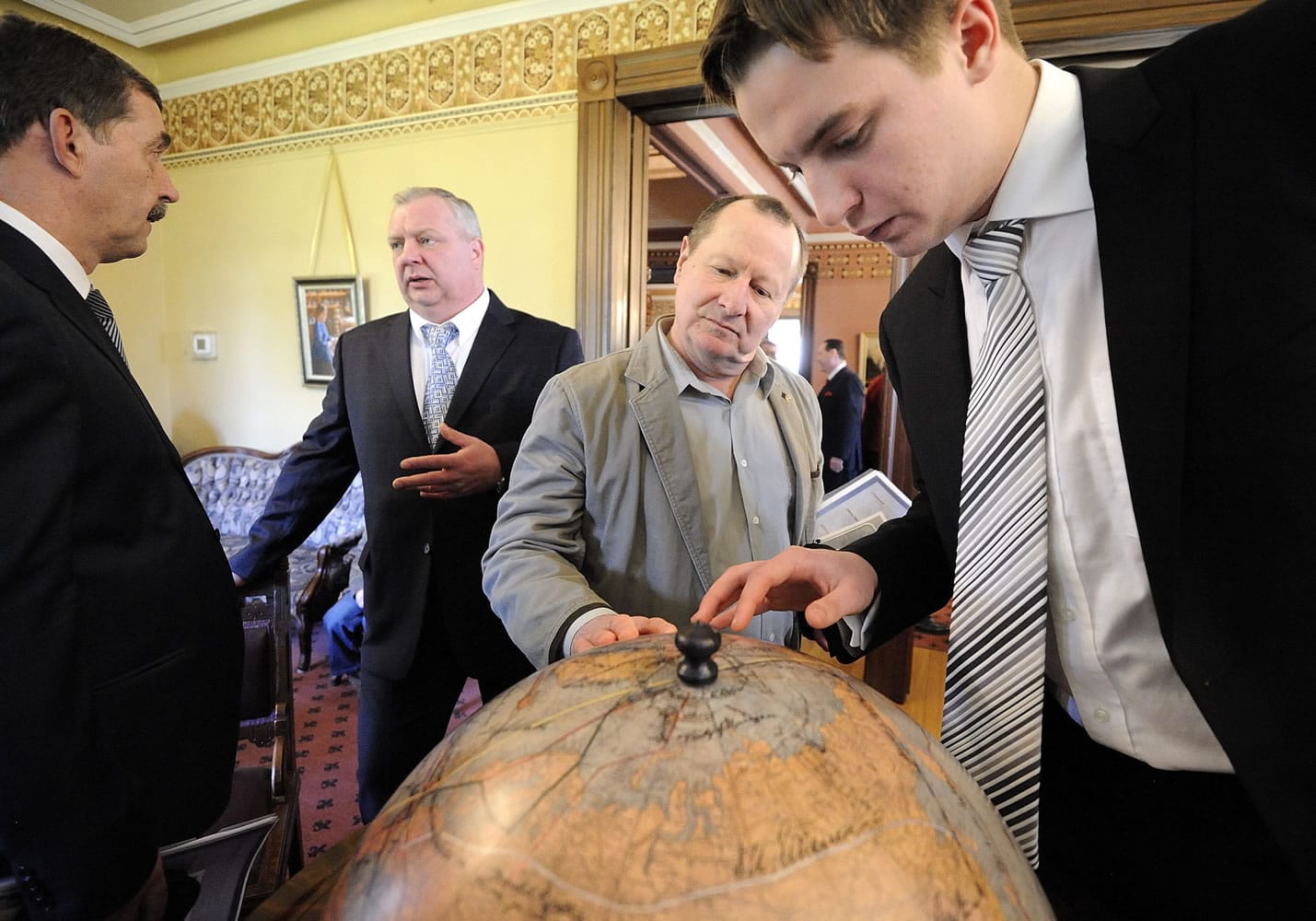The original American Geographical Society globe, signed by about 80 explorers and aviators over the last 90 years, will be in Vancouver on June 20 for the 75th anniversary of the Chkalov transpolar flight.
The American Geographical Society is conducting a survey of public attitudes toward geography and knowledge about geography as part of a major study funded by the National Science Foundation. Visit American Geographical Society.
Where on Earth was that globe?
The 18-inch sphere was autographed by some of the most acclaimed explorers and aviators of the 20th Century. They also marked the routes of their historic journeys and record-breaking flights on the globe.
Russian pilot Valery Chkalov and navigator Alexander Belyakov signed their names near the top of that globe, shortly after their 1937 Moscow-to-Vancouver transpolar flight.
Their signatures joined a list of acclaimed explorers and aviators from the previous 25 years that included Roald Amundsen, the first person to reach the South Pole; Robert Peary, the first person to reach the North Pole; Antarctic explorer Richard Byrd; Charles Lindbergh, the first to fly solo nonstop across the Atlantic; and Amelia Earhart, the first woman to fly solo across the Atlantic.
After the 1937 ceremony hosted by the American Geographical Society in New York City, Chkalov and Belyakov returned to Russia with co-pilot Georgy Baidukov, who didn’t sign the globe.
When Chkalov got back home, he told his family about the globe, said Jerry Dobson, president of the American Geographical Society.
“He died a year later in a test flight,” Dobson said. “The Chkalovs didn’t know who owned the globe, or where it was. It became family lore.”
“That was one of my father’s dreams: Find that globe,” said Valery Chkalov, grandson and namesake of the aviator.
“It was really hard; nobody knew where it was,” said the president of the International Chkalov Foundation.
The Chkalov family was behind the Iron Curtain for much of that time, making the search much harder. Then links started to form between Chkalov commemorative efforts in Russia and Vancouver.
Buck Heidrick got involved through the local Chkalov Cultural Exchange Committee, and heard the story.
“Somebody, a long time ago, had heard that there was a picture of them with the globe,” Heidrick said. He found a copy of the photo of the 1937 signing event, and then kept following Internet links that led him to the American Geographical Society, which is based in Brooklyn, N.Y.
“In November 2010, I got a call from Buck,” Dobson related. “He
said, ‘We figured out you have the globe.’”
As Dobson and Heidrick talked, both sides were able to fill in some information gaps for each other.
“They had a pretty good idea who Chkalov was, but they didn’t know Belyakov,” Heidrick said.
The continuing conversation led to the creation of 12 globe replicas, sponsored by Mikhail Slipenchuk of the Russian Geographical Society.
The Chkalov family brought one of the replicas to Vancouver for a one-day visit Friday as part of the 75th anniversary of the transpolar flight.
The original was made about 90 years ago. The shifting international landscape following World War I is reflected in how the Chkalovs’ homeland is represented.
“Look at Russia,” said Igor Chkalov, the pilot’s great-grandson, as he pointed to an unnamed land mass. “There are no signs it’s Russia or the USSR. It says Europe, Asia and Siberia.”
The replication process started when a still-life photographer took 550 photos of the original globe. A cartographer created each replica by piecing together all 550 photographed map segments, called “gores,” that had been slightly enlarged. That’s because the replica globes are 20 inches — about two inches bigger than the original.
“If it was a little bigger, the signatures would be easier to read,” Igor Chkalov said.
The Chkalovs handled another aspect of the effort, getting redwood stands built in California for the dozen replicas. The geographical society lost track of its stand at some point, so a matching stand also was built for the original globe.
The Chkalov-related organizations and geographical societies in both two countries have another collaboration. The original globe is headed to Russia for some updating.
Valery Chkalov noted that his grandfather and Belyakov are the only Russians who have signed it. On April 9, a ceremony in St. Petersburg will recognize some milestones in space flight with two new signers. Valentina Tereshkova was the first woman in space in 1963 and Alexei Leonov did the first space walk in 1965. They will add their names to those of American astronauts including John Glenn and Neil Armstrong.
Dobson has conducted several of these ceremonies in his role as president of the geographic society and can attest to their impact. He’s seen the reaction of people who just watched someone like moon-walker Armstrong sign the globe.
“The risks they take and rewards they gain for all of us: People are so in awe,” Dobson said.
“I’ve stood in the back as people leave, saying they have to do something to change their lives,”Dobson said.
Tom Vogt: 360-735-4558; http://www.twitter.com/col_history; tom.vogt@columbian.com.




